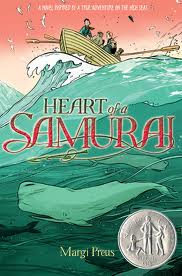

2011 Newbery Honor Book
Ratings Explanation
Language: A number of insults including racial insults such as filthy, spying Chinaman, ignorant pagan, godless cannibal, heathen, squinty-eyed, stupid. A few occasions where it’s mentioned that someone cursed or swore.
Violence: Manjiro’s hands bleed after dealing with fishing hooks. The boys are afraid the whaling men will torture them. (They are not tortured.) Whaling is described in some detail. (Harpoons in the head, iron lance into the lung, towing corpse behind a fishing boat, butchering, etc…) Shipmates tell them what they think happens to shipwrecked sailors in Japan “They put them in tiny cages afore they kill ’em.” Manjiro and Goemen are attacked on the beach. A man grabs the back of his neck, there’s a fistfight with knives and Manjiro sets a man’s beard on fire. A man points a gun at Manjiro. A father hits his son. The son is later seen bloody and bruised. A man throws a knife at a turtle and kills it.
Sexual Content: One shipmate mentions a “raven-haired maid on the Canary Islands” and some other mates laugh. A May Day tradition where a boy leaves a basket of goodies on the doorstep of a girl he likes and the girls is supposed to chase the boy and kiss him. This never happens, but Manjiro thinks about how he would like to have had Catherine chase and kiss him.
Adult Themes: A group of boys and men are stranded on an island after a large storm. Some of the men get very sick. They hunt and eat birds and anything else they can find. Two graves are found on the island. Manjiro is told he’d be more comfortable at church if he would sit on the pews that are reserved for the colored people. Boys make fun of Manjiro. Manjiro is told of a small boy dying of the fever. Three men are asked to stamp on the image of the Madonna and child to show that they reject foreign religion.
Synopsis
In 1841, Manjiro and four other fishermen are caught in a storm and find themselves stranded on an island. They are soon rescued by a large whaling boat occupied by “barbarians” from America. Knowing that they cannot return to Japan due to the closed borders of the country, they stay aboard the John Howland. Unlike his compatriots, Manjiro becomes friends with many of the crew, quickly begins to learn their language and develops a talent for whaling. During the next ten years, Manjiro travels the seas, visits new, exciting places and learns much in the way of culture and acceptance.
One of my favorite things about this book was knowing that most of the extraordinary events that Manjiro experienced actually happened. This historical fiction about the boy who is thought to be the first Japanese person to step foot in America was a great adventure. I enjoyed seeing through Manjiro’s eyes the differences between the very formal culture of his native Japan and the more casual and care-free Western way of life. I also enjoyed the information I learned from reading the book, like the 250 year period that the borders of Japan were closed from foreigners and returning countrymen.
I thought it was wonderful how the author was able to describe the experiences that Manjiro had in enough detail to be engaging to adults, but still simply enough that younger readers can understand and be excited to read more.
A favorite passage was this:
“…Mrs. Whitfield’s words had stuck in his head. Are you going to get up and help the world change?
“It was not something he’d ever though was possible before. Or at least, he had not thought that he would ever be able to bring change to the world.
“…Someone had to be making all these things happen. Someone had to be changing the world. What if he could be one of those people?”
I love this message that just one person can help change the world. And that’s just what Manjiro did.
The few scenes describing the killing and butchering of the whales might be a bit too much for sensitive children, but in general I would say that the recommended audience of 5th grade is right on.
Genre: Adventure, Grades 4-5, Grades 6-7, Grades 8-9, Historical Fiction, Newbery Medal/Honor |
No Comments











